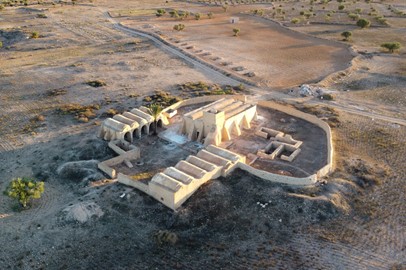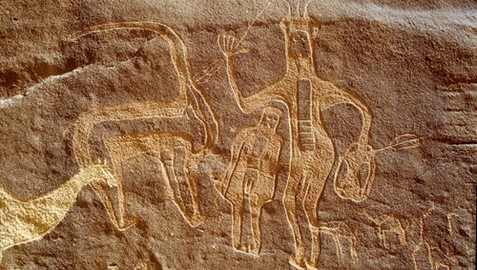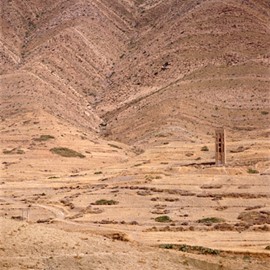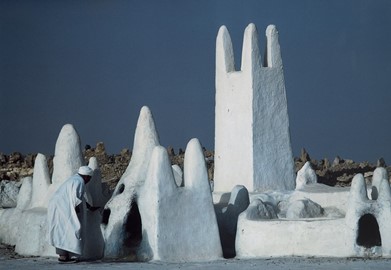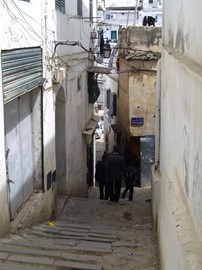region :: arab states
Umm Al Jimāl
Umm Al-Jimāl, a UNESCO World Heritage site in northern Jordan inscribed in July 2024, is an ancient rural settlement dating back to the 1st century CE, evolving from Nabataean and Roman roots into a thriving Byzantine and Early Islamic community until the 8th century. Located near the Syrian border, this 'black oasis' features well-preserved basalt structures, including houses, churches, and a sophisticated water system that supported agriculture and herding in the arid Hauran region. Its rich epigraphic re... Read More
Al Faw Archaeological Area
The Al Faw Archaeological Area, a UNESCO World Heritage site in Saudi Arabia inscribed in July 2024, is an ancient caravan city located at the crossroads of the Empty Quarter desert and Tuwaiq mountains, 650 km southwest of Riyadh. Spanning over 6,000 years, it features nearly 12,000 archaeological remains, including Neolithic tools, Bronze Age tombs, and rock art, alongside the ruins of Qaryat al-Faw, a key trade hub abandoned in the 5th century CE. This site, Saudi Arabia’s eighth UNESCO listing, showcase... Read More
Uruq Bani Ma’arid
Uruq Bani Ma’arid, a UNESCO World Heritage site in Saudi Arabia inscribed in September 2023, is a vast nature reserve in the western Empty Quarter, spanning over 12,700 square kilometers of dunes, plateaus, and gravel plains. As Saudi Arabia’s first natural UNESCO site and seventh overall, it protects a pristine desert ecosystem with reintroduced species like the Arabian oryx and critically endangered fauna such as the sand cat. Located along an ancient incense trade route, it blends ecological significance... Read More
Djerba
Djerba, a UNESCO World Heritage site in Tunisia, is a Mediterranean island renowned for its well-preserved cultural landscape, shaped by over 3,000 years of diverse human settlement. Spanning 514 square kilometers, it features traditional architecture, including whitewashed houses, fortified mosques, and underground oil presses, alongside historic trading hubs like Houmt Souk. Recognized for its unique blend of Berber, Arab, Jewish, and African influences, Djerba’s heritage reflects a resilient agro-pastora... Read More
Rachid Karami International Fair Tripoli
The Rachid Karami International Fair-Tripoli, a UNESCO World Heritage site in Lebanon, is a 70-hectare modernist complex in Tripoli, designed by Brazilian architect Oscar Niemeyer in 1962. Recognized in 2023 and listed as World Heritage in Danger, it features a distinctive boomerang-shaped exhibition hall and over 15 innovative structures, reflecting Lebanon’s 1960s modernization ambitions. Left unfinished due to the 1975 civil war, this collaboration between Niemeyer and Lebanese engineers stands as a stri... Read More
Ancient Kingdom of Saba
The Ancient Kingdom of Saba, a UNESCO World Heritage site in Yemen’s Marib region, is a collection of seven archaeological sites showcasing the wealthy Sabaean civilization from the 1st millennium BCE to around 630 CE. Recognized in 2023 and listed as World Heritage in Danger due to ongoing conflict, it features monumental temples, ramparts, and the remarkable Ma’rib Dam—an ancient engineering feat that created the largest man-made oasis in South Arabia. Situated in a semi-arid landscape, these remnants hig... Read More
As Salt
As-Salt - The Place of Tolerance and Urban Hospitality, a UNESCO World Heritage site in Jordan, recognized in 2021, is a historic hillside city in the Balqa highlands that flourished as an Ottoman trading hub from the 1860s to 1920s. Its golden limestone architecture blends European Art Nouveau and Neo-Colonial styles with local traditions, featuring notable buildings and communal spaces like guest houses (madafas). Known for its non-segregated Muslim and Christian communities, As-Salt embodies a legacy of ... Read More
Hima
Hima, a UNESCO World Heritage site in Saudi Arabia, recognized in 2021, is an ancient cultural landscape in the southwest, renowned for one of the world’s largest rock art collections. Spanning millennia, its petroglyphs and inscriptions depict hunting, wildlife, and daily life from 7,000 years ago, etched by travelers along a historic caravan route. Featuring diverse scripts like Musnad, Thamudic, Greek, and Arabic, alongside still-functioning wells, Hima offers a vivid snapshot of human history and cultur... Read More
Babylon
Babylon, a UNESCO World Heritage site in Iraq, recognized in 2019, is an ancient Mesopotamian city south of Baghdad, thriving from the 18th to 6th centuries BCE as a capital of the Babylonian Empire. Renowned for its mudbrick ruins—including remnants of the Ishtar Gate, ziggurat foundations, and city walls—it reflects advanced urban planning, architecture, and cultural achievements like the Code of Hammurabi. This iconic site embodies Iraq’s pivotal role in early civilization, offering a tangible link to on... Read More
Dilmun Burial Mounds
The Dilmun Burial Mounds, a UNESCO World Heritage site in Bahrain, recognized in 2019, are a vast necropolis of over 11,000 ancient tombs dating from 2050 to 1750 BCE, linked to the Bronze Age Dilmun civilization. These beehive-shaped, stone-built mounds, scattered across fields, reflect a sophisticated funerary tradition tied to Bahrain’s role as a thriving trade hub in the Persian Gulf. Offering insight into Dilmun’s social structure and beliefs, this archaeological landscape preserves a key chapter of th... Read More
Al Qal'a of Beni Hammad
Al Qal’a of Beni Hammad, a UNESCO World Heritage site in Algeria, recognized in 1980, is an 11th-century fortified city in a mountainous region, once the capital of the Hammadid dynasty. Its ruins—featuring a grand mosque, palace, and defensive walls—reflect early Islamic urban planning and architecture in North Africa. This well-preserved site showcases Algeria’s medieval heritage, offering a glimpse into a vanished Berber dynasty’s cultural and political legacy.
Tassili n'Ajjer
Tassili n’Ajjer, a UNESCO World Heritage site in Algeria, recognized in 1982, is a vast desert plateau in the Sahara renowned for its prehistoric rock art and geological wonders. Featuring over 15,000 paintings and engravings from 6000 BCE, depicting ancient life and animals, it lies amid dramatic sandstone arches and canyons. This site showcases Algeria’s rich archaeological and natural heritage, preserving a vivid record of humanity’s early past in a stark, timeless landscape.
M'Zab Valley
M’Zab Valley, a UNESCO World Heritage site in Algeria, recognized in 1982, is a 10th-century oasis settlement in the Sahara, founded by the Ibadi Muslim sect. Its five fortified towns, or ksour, feature palm grove irrigation, mudbrick architecture, and a minimalist mosque design, reflecting a unique communal lifestyle. This well-preserved site showcases Algeria’s cultural heritage, blending human ingenuity with a harsh desert environment in a timeless urban landscape.
Djémila
Djémila, a UNESCO World Heritage site in Algeria, recognized in 1982, is a Roman city founded in the 1st century CE, nestled in a hilly landscape. Known as Cuicul, its well-preserved ruins—featuring a forum, temples, basilicas, and a theater—reflect sophisticated urban planning adapted to rugged terrain. This site showcases Algeria’s ancient heritage, offering a striking testament to Roman architecture and life in North Africa.
Tipasa
Tipasa, a UNESCO World Heritage site in Algeria, recognized in 1982 and listed as World Heritage in Danger from 2002-2006, is an ancient coastal city with Punic, Roman, and early Christian ruins from the 6th century BCE to the 6th century CE. Its scenic remains—featuring a theater, basilicas, and mausoleums—blend Mediterranean beauty with historical layers along the sea. This site showcases Algeria’s rich archaeological heritage, preserving a crossroads of civilizations despite past threats.
Timgad
Timgad, a UNESCO World Heritage site in Algeria, recognized in 1982, is a Roman colonial city founded in 100 CE by Emperor Trajan, laid out in a perfect grid in the Aurès Mountains. Its well-preserved ruins—featuring a triumphal arch, theater, and baths—reflect a model of Roman urban planning in North Africa. This site showcases Algeria’s ancient heritage, offering a vivid snapshot of imperial Rome’s reach and architectural prowess.
Kasbah of Algiers
The Kasbah of Algiers, a UNESCO World Heritage site in Algeria, recognized in 1992, is a historic citadel in Algiers, built from the 10th century under Berber dynasties and reshaped by Ottoman rule. Its labyrinth of narrow streets, whitewashed houses, mosques, and palaces reflects a unique blend of Islamic and Mediterranean architecture. This site showcases Algeria’s cultural heritage, preserving a vibrant urban tapestry of medieval and colonial influences overlooking the sea.
Pearling
Pearling, a UNESCO World Heritage site in Bahrain, is a historic testament to the region’s centuries-old pearl-diving tradition and economic heritage. Centered around preserved oyster beds, merchant houses, and a fortress, it showcases the architecture and lifestyle tied to the once-thriving pearl industry. Traditional wooden dhows and coastal sites reflect the skill and resilience of divers who shaped Bahrain’s identity. This cultural landscape highlights the intersection of nature, trade, and human endeav... Read More
Qal’at al Bahrain
Qal’at al-Bahrain, a UNESCO World Heritage site in Bahrain, is an ancient fortress and archaeological marvel renowned for its layered history. This coastal citadel, with roots tracing back over 4,000 years, features remnants of Dilmun, Persian, and Portuguese civilizations, including a towering fort and intricate ruins. Once a thriving trading hub, it overlooks the sea with stone walls and mounds revealing artifacts of past cultures. This well-preserved site stands as a testament to Bahrain’s strategic and ... Read More
Memphis and its Necropolis
Memphis and its Necropolis, a UNESCO World Heritage site in Egypt, is an ancient capital from 3100 BCE, renowned for its vast burial grounds and monumental pyramids. Featuring the Great Sphinx and Giza’s iconic structures, it reflects the architectural genius and spiritual beliefs of early Egyptian civilization. This historic site offers a profound glimpse into antiquity’s grandeur.
Thebes Necropolis
The Thebes Necropolis, a UNESCO World Heritage site in Egypt, is an ancient burial ground from the New Kingdom era, famed for its rock-cut tombs and temples. Featuring the Valley of the Kings and grand mortuary complexes, it showcases intricate art and royal burials. This site offers a stunning window into Egypt’s pharaonic heritage.
Abu Simbel Nubian Monuments
The Abu Simbel Nubian Monuments, a UNESCO World Heritage site in Egypt, are colossal 13th-century BCE temples carved into a cliff by Ramses II. Featuring massive statues and intricate reliefs, they were relocated in the 1960s to save them from flooding. This site showcases ancient Egyptian engineering and royal legacy.
Cairo
Historic Cairo, a UNESCO World Heritage site in Egypt, is a medieval Islamic city founded in the 10th century, renowned for its mosques, madrasas, and bustling bazaars. Featuring ornate minarets and ancient walls, it reflects centuries of architectural and cultural evolution. This vibrant site offers a rich tapestry of Egypt’s Islamic heritage.
Abu Mena
Abu Mena, a UNESCO World Heritage site in Egypt, is an early Christian pilgrimage center from the 4th century, featuring ruins of a basilica, monastery, and baptistery. Built over the tomb of Saint Menas, its intricate remains reflect the rise of Coptic Christianity. This archaeological site offers a glimpse into Egypt’s religious past.
Saint Catherine Area
The Saint Catherine Area, a UNESCO World Heritage site in Egypt, is a sacred desert landscape centered around the 6th-century Saint Catherine’s Monastery. Nestled beneath rugged mountains, it features ancient manuscripts and a chapel atop Mount Sinai, tied to biblical history. This site blends spiritual significance with natural grandeur.



